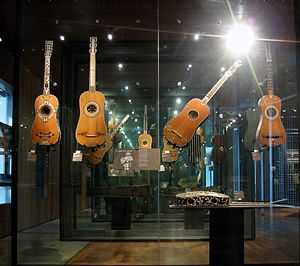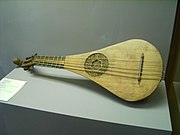Acoustic guitar

An acoustic guitar is a guitar that uses only acoustic means to transmit the strings' vibrational energy to the air in order to make a sound. Acoustic means not electric or using electric impulses (see Electric guitar). The sound waves of an acoustic guitar are directed through the body of the guitar creating a sound. This typically involves the use of a sound board and a sound box to strengthen the vibrations of the strings.
The main source of sound in an acoustic guitar is the string, which is plucked with the finger or with a plectrum. The string vibrates at a necessary frequency and also create many harmonics at various different frequencies. The frequencies produced can depend on string length, mass, and tension. The string causes the soundboard and sound box to vibrate, and as these have their own resonances at certain frequencies, they amplify some string harmonics more strongly than others, hence affecting the timbre produced by the instrument.
Acoustic properties
The acoustic guitar's soundboard, or top, also has a strong effect on the loudness of the guitar. No amplification actually occurs in this process, because no external energy is added to increase the loudness of the sound (as would be the case with an electronic amplifier). All the energy is provided by the plucking of the string. But without a soundboard, the string would just "cut" through the air without actually moving it much. The soundboard increases the surface of the vibrating area in a process called mechanical impedance matching. The soundboard can move the air much more easily than the string alone, because it is large and flat. This increases the entire system's energy transfer efficiency, and a much louder sound is emitted.
 |
Acoustic Guitar Sample
Spanish Romance. |
| Problems playing this file? See media help. | |
 |
Acoustic Guitar Sample
An example of the sounds which an acoustic guitar can create through vibration of its strings. This guitar uses steel strings. |
| Problems playing this file? See media help. | |

In addition, the acoustic guitar has a hollow body and an additional coupling and resonance effect increases the efficiency of energy transmission in lower frequencies. The air in a guitar's cavity resonates with the vibrational modes of the string and soundboard. At low frequencies, which depend on the size of the box, the chamber acts like a Helmholtz resonator, increasing or decreasing the volume of the sound again depending on whether the air in the box is moving in phase or out of phase with the strings. When in phase, the sound is increased by about 3 decibels and when in opposing phase, it is decreased about 3 decibels. As a Helmholtz resonator, the air at the opening is vibrating in or out of phase with the air in the box and in or out of phase with the strings. These resonance interactions attenuate or amplify the sound at different frequencies, boosting or damping various harmonic tones. Ultimately, the cavity air vibrations couple to the outside air through the sound hole,[1] though some variants of the acoustic guitar omit this hole, or have  holes, like a violin family instrument (a trait found in some electric guitars such as the ES-335 and Lucille models from Gibson). This coupling is most efficient because here the impedance matching is perfect: it is air pushing air.
holes, like a violin family instrument (a trait found in some electric guitars such as the ES-335 and Lucille models from Gibson). This coupling is most efficient because here the impedance matching is perfect: it is air pushing air.
There are therefore several sound coupling modes in an acoustic guitar: string to soundboard, soundboard to cavity air, and both soundboard and cavity air, to outside air. The back of the guitar will also vibrate to a lesser extent, driven by the air in the cavity. The function of the entire acoustic system is twofold: to color the sound through the generation and amplification of harmonics, and to maximize the coupling of this energy to the surrounding air — which is ultimately what we perceive as loudness of the produced sound. Improved coupling, however, comes at the expense of decay time, since now the string's energy is more efficiently transmitted. An unamplified guitar (one with no soundboard at all) would have a low volume, but the strings would vibrate much longer, like a tuning fork.
All these complex air coupling interactions, along with the resonant properties of the panels themselves, are a key reason that different guitars will have different tonal qualities. The sound is a complex mixture of harmonics that give the guitar its distinctive sound.
Amplification
Classical gut-string guitars had little projection, and so were unable to displace banjos until innovations increased their volume.
Two important innovations were introduced by the American firm, Martin Guitars. First, Martin introduced steel strings. Second, Martin increased the area of the guitar top; the popularity of Martin's larger "dreadnought" body size amongst acoustic performers is related to the greater sound volume produced. These innovations allowed guitars to compete with and often displace the banjos that had previously dominated jazz bands. The steel-strings increased tension on the neck; for stability, Martin reinforced the neck with a steel truss rod, which became standard in later steel-string guitars.[3]
An acoustic guitar can be amplified by using various types of pickups or microphones. However, amplification of acoustic guitars had many problems with audio feedback. In the 1960s, Ovation's parabolic bowls dramatically reduced feedback, allowing greater amplification of acoustic guitars.[4] In the 1970s, Ovation developed thinner sound-boards with carbon-based composites laminating a thin layer of birch, in its Adamas model, which has been viewed as one of the most radical designs in the history of acoustic guitars. The Adamas model dissipated the sound-hole of the traditional soundboard among 22 small sound-holes in the upper chamber of the guitar, yielding greater volume and further reducing feedback during amplification.[4] Another method for reducing feedback is the use of a rubber or plastic disc which fits into the soundhole.
The most common type of pickups used for acoustic guitar amplification are piezo and magnetic pickups. Piezo pickups are generally mounted under the bridge saddle of the acoustic guitar and can be plugged into a mixer or amplifier. A Piezo pickup made by Baldwin was incorporated in the body of Ovation guitars, rather than attached by drilling through the body;[5] the combination of the Piezo pickup and parabolic ("roundback") body helped Ovation to lead the market during the 1970s.[6] Magnetic pickups are generally mounted in the sound hole of the acoustic guitar and are very similar to those found in electric guitars. An acoustic guitar with pickups for electrical amplification is known as an acoustic-electric guitar.
In the 2000s, new types of pickups have been introduced to try to amplify the full sound of these instruments. This includes body sensors such as the Taylor Guitars Expression System®,[7] and systems that include an internal microphone along with the body sensors or under-the-saddle pickups.
Types
Historical and modern acoustic guitars are extremely varied in their design and construction, far more so than electric guitars. Some of the most important varieties are the classical guitar (nylon-stringed), steel-string acoustic guitar and lap steel guitar. A more complete list is given below, refer to the individual articles for more specific detail.
%2C_Matteo_Sellas%2C_The_Met%2C_NYC.jpg)
- Nylon/gut stringed guitars:
- Vihuela
- Gittern
- Baroque guitar
- Romantic guitar
- Classical guitar, the modern version of the original guitar, including additional strings models
- Lute
- Steel stringed guitars:
- Steel-string acoustic guitar, also known as western, folk or country guitar
- Twelve string guitar
- Resonator guitar (such as the Dobro)
- Archtop guitar
- Selmer/Maccaferri (Manouche) guitar
- Battente guitar
- Lap steel guitar
- Lap slide guitar
- Parlor guitar
- Lyre-guitar
- Other variants:
- Harp guitar
- Pikasso guitar (a variant of harp guitar)
- Contraguitar (Viennese variant of harp guitar)
- Acoustic bass guitar
- Banjo guitar
Gallery
-
Gittern (1450)
-

Baroque (17th century)
-

Lute (17th century)
-

Romantic (c. 1830)
-

Ten-string
-
%2C_Museum_of_Making_Music.jpg)
Hawaiian (c. 1920)
References
- ↑ How a guitar works
- ↑ Carter (1996, p. 127)
- ↑ Denyer (1992, pp. 44–45)
- ↑ 4.0 4.1 Denyer (1992, p. 48)
- ↑ Carter (1996, pp. 48–52)
- ↑ DenyerOvation
- ↑ "Taylor Guitars Expression System". Taylor Guitars. Retrieved 2 April 2014.
References
- Carter, Walter (1996). Eiche, Jon, ed. The history of the Ovation guitar. Musical Instruments Series (first ed.). Milwaukee, Wisconsin: Hal Leonard Corporation. pp. 1–128. HL00330187; ISBN 978-0-7935-5876-6; ISBN 0-7935-5876-X (softcover); ISBN 0-7935-5948-0 (hardcover).
- Denyer, Ralph (1992). The guitar handbook. Special contributors Isaac Guillory and Alastair M. Crawford; Foreword by Robert Fripp (Fully revised and updated ed.). London and Sydney: Pan Books. ISBN 0-330-32750-X.
| Wikimedia Commons has media related to Acoustic guitars. |
| ||||||||||||||||||||||||||||||||||||||||||||||||||||||||

%2C_Kay_Kraft_guitar%2C_Museum_of_Making_Music.jpg)




.jpg)

.jpg)

